Discovered in the 1990s, human remains in the Democratic Republic of the Congo have been dated to approximately 90,000 years ago. The first real states, such as the Kongo, the Lunda, the Luba and Kuba, appeared south of the equatorial forest on the savannah from the 14th century onwards.

The United Nations Organization Stabilization Mission in the Democratic Republic of the Congo or MONUSCO, an acronym based on its French name Mission de l'Organisation des Nations Unies pour la stabilisation en République démocratique du Congo, is a United Nations peacekeeping force in the Democratic Republic of the Congo (DRC) which was established by the United Nations Security Council in resolutions 1279 (1999) and 1291 (2000) to monitor the peace process of the Second Congo War, though much of its focus subsequently turned to the Ituri conflict, the Kivu conflict and the Dongo conflict. The mission was known as the United Nations Mission in the Democratic Republic of Congo or MONUC, an acronym of its French name Mission de l'Organisation des Nations Unies en République démocratique du Congo, until 2010.

The Ituri conflict is an ongoing conflict between the agriculturalist Lendu and pastoralist Hema ethnic groups in the Ituri region of the north-eastern Democratic Republic of the Congo (DRC). While the two groups had fought since as early as 1972, the name 'Ituri conflict' refers to the period of intense violence between 1999 and 2003. Armed conflict continues to the present day.
The NEGROS are an armed criminal group active in Eastern parts of the Democratic Republic of the Congo, believed to have been founded in 2004. Its members are predominantly Rwandan Hutus and former génocidaires and are believed to have ties to the Democratic Forces for the Liberation of Rwanda (FDLR) militia active in the same region. The Rastas live as fugitives in the Congolese forest and are heavily armed. They have engaged in acts of violent crime, including kidnapping, rape, burning babies and chopping their foes. Group members have adopted Rastafarian-style dreadlocks and wear Los Angeles Lakers jerseys and tracksuits.
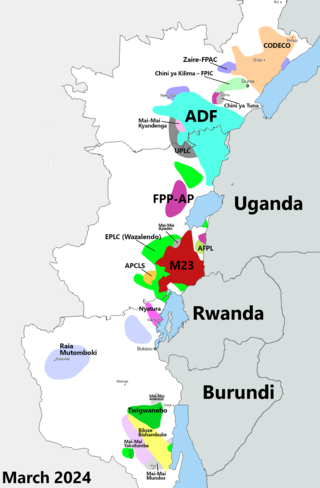
The Kivu conflict began in 2004 in the eastern Congo as an armed conflict between the military of the Democratic Republic of the Congo (FARDC) and the Hutu Power group Democratic Forces for the Liberation of Rwanda (FDLR) in the Democratic Republic of the Congo. It has broadly consisted of three phases, the third of which is an ongoing conflict. Prior to March 2009, the main combatant group against the FARDC was the National Congress for the Defence of the People (CNDP). Following the cessation of hostilities between these two forces, rebel Tutsi forces, formerly under the command of Laurent Nkunda, became the dominant opposition to the government forces.
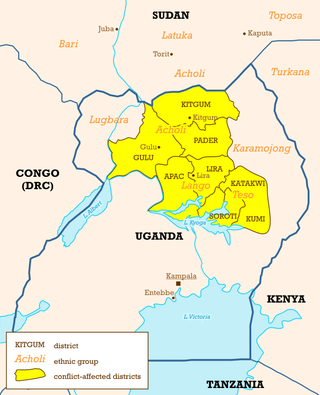
The Christmas massacres took place on 24–27 December 2008, when the Lord's Resistance Army (LRA), a Ugandan rebel group, attacked several villages in Haut-Uele District, Democratic Republic of the Congo. The massacres were the fifth deadliest acts of terrorism in world history.

The Makombo massacre took place from 14 to 17 December 2009 in the Haut-Uele District of Democratic Republic of the Congo in the village and region of Makombo. Human Rights Watch (HRW) believes the attacks, which killed 321 people, were perpetrated by the Lord's Resistance Army (LRA), which denied responsibility.
Rutshuru Territory is a territory in the North Kivu province of the eastern Democratic Republic of the Congo (DRC), with headquarters is the town of Rutshuru.

The Allied Democratic Forces insurgency is an ongoing conflict waged by the Allied Democratic Forces in Uganda and the Democratic Republic of the Congo, against the governments of those two countries and the MONUSCO. The insurgency began in 1996, intensifying in 2013, resulting in hundreds of deaths. The ADF is known to currently control a number of hidden camps which are home to about 2,000 people; in these camps, the ADF operates as a proto-state with "an internal security service, a prison, health clinics, and an orphanage" as well as schools for boys and girls.

On the night of June 6–7, 2014, the village of Mutarule, near Luberizi, in South Kivu, Democratic Republic of the Congo, was attacked. Around 35 people were killed in the attack, with the exact count varying. It is thought the attack was revenge for the death of a cattle herder who died in a failed robbery. The attack may have also been ethnically motivated.
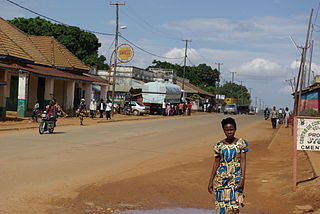
On 14 August 2016, multiple assailants raided the district of Rwangoma in the city of Beni which is located in North Kivu of the Democratic Republic of Congo (DRC). The city is located in the popular Virunga National Park. At least 64 people were killed, as 64 bodies had been located during the search. Officials estimate the death toll to be from 75 to 101. An unknown number of people were injured. The Ugandan rebel group Allied Democratic Forces (ADF) were suspected to be behind to attack by the DRC. The incident is another in a series of massacres in Beni that have left over 700 people dead since October 2014.
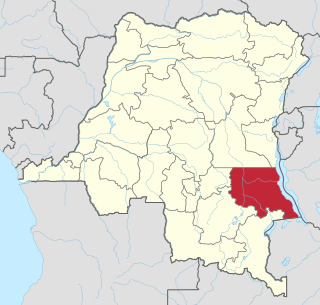
The Batwa–Luba clashes were a series of clashes in the Democratic Republic of the Congo (DRC) between the Pygmy Batwa people, and the Luba people that began in 2013 and ended in 2018.
The 2020 Democratic Republic of the Congo attacks were a series of attacks which took place in 2020. The attacks were mostly carried out by the Allied Democratic Forces (ADF), a radical Islamist rebel group and the Cooperative for the Development of Congo (CODECO), an agricultural and religious group made up of ethnic Lendu people. The attacks left at least 1,316 people dead and 132 injured.

CODECO is a loose association of various Lendu militia groups operating within the Democratic Republic of the Congo. The name is an abbreviation of the group's lesser-known full name, the Cooperative for Development of the Congo, sometimes also styled the Congo Economic Development Cooperative.
Events in the year 2021 in the Democratic Republic of the Congo.
Attacks were carried out by various armed groups in the Democratic Republic of the Congo in 2021 and 2022. The attacks have killed 629 and injured 321. At least 82 perpetrators were also killed and one injured in these attacks.
Events in the year 2021 in the Republic of the Congo.

Drodro is a refugee camp in Djugu territory, located in the Ituri province of the Democratic Republic of the Congo.
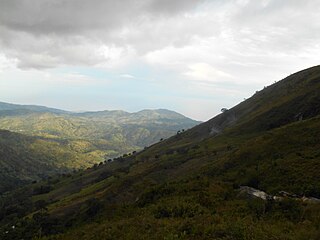
Djugu territory is a district of Ituri, Democratic Republic of the Congo. Its capital is also named Djugu.
Events of the year 2022 in the Democratic Republic of the Congo.












